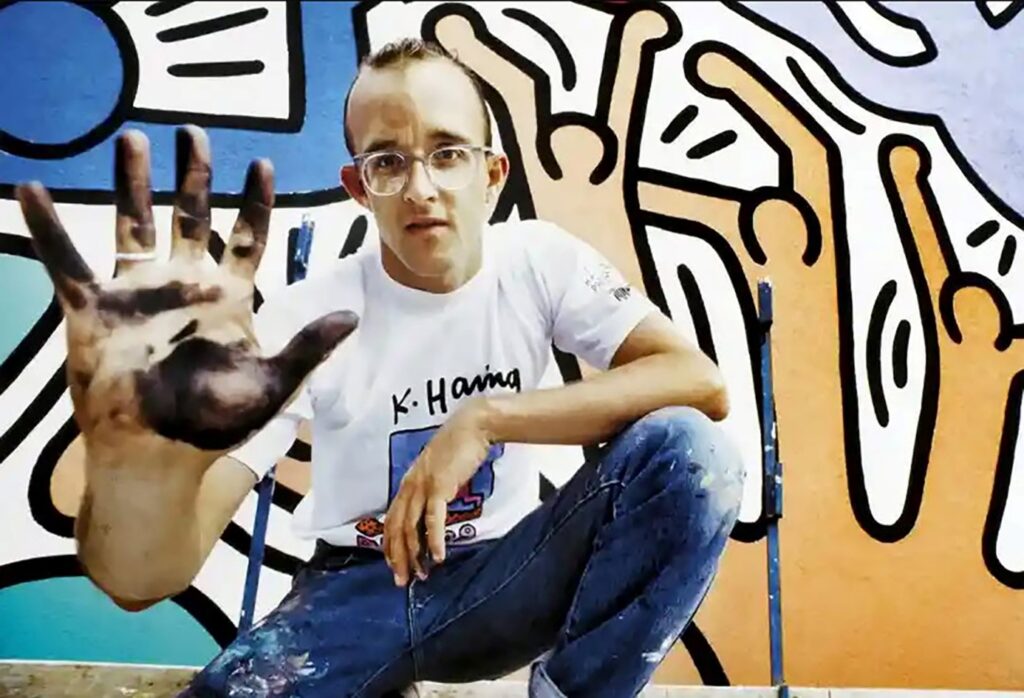
Keith Allen Haring (May 4, 1958 – February 16, 1990) was an American artist whose pop art emerged from the New York City graffiti subculture of the 1980s. His animated imagery has “become a widely recognized visual language”. Much of his work includes sexual allusions that turned into social activism by using the images to advocate for safe sex and AIDS awareness. In addition to solo gallery exhibitions, he participated in renowned national and international group shows such as Documenta in Kassel, the Whitney Biennial in New York, the São Paulo Biennial, and the Venice Biennale. The Whitney Museum held a retrospective of his art in 1997.
Haring’s popularity grew from his spontaneous drawings in New York City subways—chalk outlines of figures, dogs, and other stylized images on blank black advertising spaces. After gaining public recognition, he created colorful larger scale murals, many commissioned. He produced more than 50 public artworks between 1982 and 1989, many of them created voluntarily for hospitals, day care centers and schools. In 1986, he opened the Pop Shop as an extension of his work. His later work often conveyed political and societal themes— anti-crack, anti-apartheid, safe sex, homosexuality and AIDS—through his own iconography.
Haring died on February 16, 1990, of AIDS-related complications. In 2014, he was one of the inaugural honorees in the Rainbow Honor Walk in San Francisco, a walk of fame noting LGBTQ people who have “made significant contributions in their fields”. In 2019, he was one of the inaugural 50 American “pioneers, trailblazers, and heroes” inducted on the National LGBTQ Wall of Honor within the Stonewall National Monument in New York City’s Stonewall Inn.
Haring was born in Reading, Pennsylvania, on May 4, 1958. He was raised in Kutztown, Pennsylvania, by his mother, Joan Haring, and father, Allen Haring, an engineer and amateur cartoonist. He had three younger sisters, Kay, Karen and Kristen. He became interested in art at a very young age, spending time with his father producing creative drawings. His early influences included Walt Disney cartoons, Dr. Seuss, Charles Schulz, and the Looney Tunes characters in The Bugs Bunny Show.
Haring’s family attended the United Church of Christ. In his early teenage years, he was involved with the Jesus Movement. He later hitchhiked across the country, selling T-shirts he made featuring the Grateful Dead and anti-Nixon designs. He graduated from Kutztown Area High School in 1976. He studied commercial art from 1976 to 1978 at Pittsburgh’s Ivy School of Professional Art, but eventually lost interest, inspired to focus on his own art after reading The Art Spirit (1923) by Robert Henri.
Haring had a maintenance job at the Pittsburgh Center for the Arts and was able to explore the art of Jean Dubuffet, Jackson Pollock, and Mark Tobey. He was highly influenced around this time by a 1977 retrospective of Pierre Alechinsky’s work and by a lecture that the sculptor Christo gave in 1978. From Alechinsky’s work, he felt encouraged to create large images that featured writing and characters. From Christo, Haring was introduced to ways of incorporating the public into his art. His first significant one-man exhibition was in Pittsburgh at the Center for the Arts in 1978.
Haring moved to the Lower East Side of New York in 1978 to study painting at the School of Visual Arts. He also worked as a busboy during this time at the nightclub Danceteria. While attending school he studied semiotics with Bill Beckley and experimented with video and performance art. Haring was also highly influenced in his art by author William Burroughs.
Haring’s work demonstrates political and personal influences. References to his sexual orientation are apparent throughout his work, and his journals confirm its impact on his work. There are symbolic allusions to the AIDS epidemic in some of his later pieces, such as Untitled, Silence=Death and his sketch Weeping Woman. In some of his works the symbolism is subtle, but he also produced some blatantly activist works. Silence=Death, which mirrors the ACT UP poster and uses its motto, is almost universally agreed upon as a work of HIV/AIDS activism.
During his lifetime, Haring had over 50 solo exhibitions, and was represented by well-known galleries such as the Tony Shafrazi Gallery and the Leo Castelli Gallery. Since his death, has been featured in over 150 exhibitions around the world. He has also been the subject of several international retrospectives.


